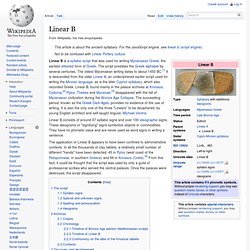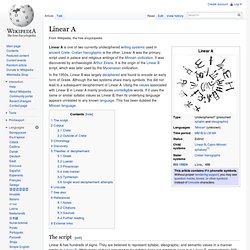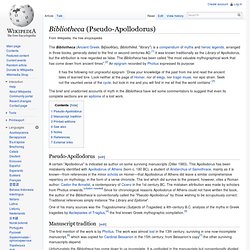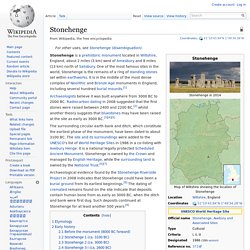

Linear B. Linear B is a syllabic script that was used for writing Mycenaean Greek, the earliest attested form of Greek.

The script predates the Greek alphabet by several centuries. The oldest Mycenaean writing dates to about 1450 BC.[1] It is descended from the older Linear A, an undeciphered earlier script used for writing the Minoan language, as is the later Cypriot syllabary, which also recorded Greek. Linear B, found mainly in the palace archives at Knossos, Cydonia,[2] Pylos, Thebes and Mycenae,[3] disappeared with the fall of Mycenaean civilization during the Bronze Age Collapse. The succeeding period, known as the Greek Dark Ages, provides no evidence of the use of writing. It is also the only one of the three "Linears" to be deciphered, by young English architect and self-taught linguist, Michael Ventris. Linear B consists of around 87 syllabic signs and over 100 ideographic signs. The application of Linear B appears to have been confined to administrative contexts. Linear A. Linear A is one of two currently undeciphered writing systems used in ancient Crete.

Cretan hieroglyphic is the other. Linear A was the primary script used in palace and religious writings of the Minoan civilization. It was discovered by archaeologist Arthur Evans. It is the origin of the Linear B script, which was later used by the Mycenaean civilization. The script[edit] Linear A has hundreds of signs. Corpus[edit] Linear A has been unearthed chiefly on Crete, but also at other sites in Greece, as well as Turkey and Israel. Crete[edit] According to Ilse Schoep, on Crete, the main discoveries of Linear A tablets have been at three sites: Phaistos Disc. The Phaistos Disc (also spelled Phaistos Disk, Phaestos Disc) is a disk of fired clay from the Minoan palace of Phaistos on the Greek island of Crete, possibly dating to the middle or late Minoan Bronze Age (2nd millennium BC).

It is about 15 cm (5.9 in) in diameter and covered on both sides with a spiral of stamped symbols. Its purpose and meaning, and even its original geographical place of manufacture, remain disputed, making it one of the most famous mysteries of archaeology. This unique object is now on display at the archaeological museum of Heraklion. The disc was discovered in 1908 by the Italian archaeologist Luigi Pernier in the Minoan palace-site of Phaistos, and features 241 tokens, comprising 45 unique signs, which were apparently made by pressing hieroglyphic "seals" into a disc of soft clay, in a clockwise sequence spiraling toward the disc's center. Discovery Tablet PH-1 It was found in the main cell of an underground "temple depository". Authenticity Dating Typography Signs. Bibliotheca (Pseudo-Apollodorus) The Bibliotheca (Ancient Greek: Βιβλιοθήκη, Bibliothēkē, "library") is a compendium of myths and heroic legends, arranged in three books, generally dated to the first or second centuries AD.[1] It was known traditionally as the Library of Apollodorus, but the attribution is now regarded as false.

The Bibliotheca has been called "the most valuable mythographical work that has come down from ancient times".[2] An epigram recorded by Photius expressed its purpose: It has the following not ungraceful epigram: 'Draw your knowledge of the past from me and read the ancient tales of learned lore. Look neither at the page of Homer, nor of elegy, nor tragic muse, nor epic strain. Seek not the vaunted verse of the cycle; but look in me and you will find in me all that the world contains'.[3] The brief and unadorned accounts of myth in the Bibliotheca have led some commentators to suggest that even its complete sections are an epitome of a lost work. Stonehenge. Archaeologists believe it was built anywhere from 3000 BC to 2000 BC.

Radiocarbon dating in 2008 suggested that the first stones were raised between 2400 and 2200 BC,[2] whilst another theory suggests that bluestones may have been raised at the site as early as 3000 BC.[3][4][5] The surrounding circular earth bank and ditch, which constitute the earliest phase of the monument, have been dated to about 3100 BC. The site and its surroundings were added to the UNESCO's list of World Heritage Sites in 1986 in a co-listing with Avebury Henge.
It is a national legally protected Scheduled Ancient Monument. Stonehenge is owned by the Crown and managed by English Heritage, while the surrounding land is owned by the National Trust.[6][7] Etymology The Oxford English Dictionary cites Ælfric's tenth-century glossary, in which henge-cliff is given the meaning "precipice", or stone, thus the stanenges or Stanheng "not far from Salisbury" recorded by eleventh-century writers are "supported stones".